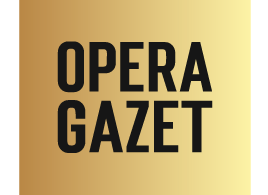IL PIRATA – A NOT-SO-FIERCE PIRATE. “Se fui spietato e fiero, fui sventurato ancor” (“If I was ruthless and proud, I also was wretched”) says Gualtiero, the Pirate, before surrendering to his enemies to be beheaded (but after having killed his rival Ernesto in a duel). This sentence would be enough to legitimise the opinion of those who see him as the first example, in opera, of the “dark, brooding hero” so dear to Romantic literature.
Yet it’s not that simple, since Gualtiero, “conceived” by the music of Vincenzo Bellini and the libretto of Felice Romani, is a “borderline” character. Let’s try to explain the reasoning behind our statement.
The work was conceived in 1827. So, from the point of view of the history of literature, at the height of Romanticism. But music is, by nature, slower to adapt to cultural upheavals. While anyone (up to a certain point) can pick up a pen and write a story, music follows rules and traditions that require extensive study and in-depth skills. A musical style does not change overnight. And so, while the beautiful libretto by Felice Romani fits perfectly in the framework of Romantic literature, and indeed in some points it even tends to the Gothic, Bellini gives it a musical, and above all, vocal frame still linked to the previous century (it’s no coincidence that three years later, in I Capuleti e i Montecchi, he will write, for the male protagonist of the plot, a part for alto “in travesti”, almost reconnecting to the tradition linked to castrati).
You can have any review automatically translated. Click the Google Translate button (“Vertalen”), which can be found at the top right of the page. In the Contact Page, the button is in the right column. Select your language at the upper left.
Vincenzo Bellini: IL PIRATA. Melodramma in due atti su libretto di Felice Romani.
Ernesto: Luca Salsi
Imogene: Sondra Radvanovsky
Gualtiero: Celso Albelo
Itulbo: Francesco Pittari
Goffredo: Emanuele Cordaro
Adele: Anna Maria Sarra
Orchestra e Coro del Teatro di San Carlo
Direttore: Antonino Fogliani
Maestro del Coro: Gea Garatti Ansini
Musica: *4,5*
Direzione: *3,5*
In our opinion, this is one of the reasons why this beautiful, fascinating work is so rarely staged: the difficulty of reconciling, in the role of the protagonist, the fierceness (sometimes the ferocity), of a “heroic” tenor with stormy impulses, with the music that Bellini himself defined “angelic”, characterised by a high “tessitura” and numerous passages of agility. This difficulty must have manifested itself very quickly, if the opera, written for Giovanni Battista Rubini, an exquisite bel canto singer, quickly became part of Gilbert Duprez’s repertoire, the tenor famous for having “invented” the “Do di petto” (high C from the chest) that so excited Alexandre Dumas père. Today, we don’t know from direct experience how Rubini and Duprez sang, but we can say with some certainty that they were, in terms of voice and style, two totally different tenors.
The opera remained on the fringes of the repertoire for a long time. It emphatically resurfaced in the headlines in 1958, when one of the great so-called “traditional” conductors, Antonino Votto, “invented” (we believe we can use this word) a rendition that, at La Scala, thrilled the public and even the critics, thanks, above all, to the extraordinary cast of protagonists: Callas, Corelli, Bastianini. Unfortunately, no one, except those who were present, knows anything about that production, of which no recorded document remains. It is clear, however, that by entrusting the role to Franco Corelli, Votto favoured the “heroic” vision of Gualtiero, rather than the bel canto angle in a technical sense. The experiment was much criticised in the subsequent era of the triumph of “philology” as one of the many choices in bad taste of 1950s opera. And, given the impossibility of finding a tenor suited to reconcile the two “facets” of Gualtiero, the focus shifted to the female protagonist. Callas first, and, years later, Caballé, made Imogene one of the most demanding, but also most loved roles in the repertoire.
For Gualtiero, various solutions were adopted, mostly of the fallback variety, in which the most difficult parts were cut and “levelled”… until the advent of Rockwell Blake, who, although he performed the role in only two productions, and several years apart, was the only Gualtiero able to reconcile tenor heroic momentum and “coloratura” singing in a holistic way.
In recent years, Il Pirata reappears a little more frequently on stage. Many sopranos, even of the younger generations, try their hand at the role of Imogene. Rarer, as usual, are the tenors. And in our opinion (in addition to the many recordings, we have had the good fortune to also see two editions live, at the Teatro delle Muse Franco Corelli in Ancona and at La Scala in Milan), the ideal interpreter has not yet been found.
We hope we haven’t bored our Opera Gazet readers with this long preamble, which seemed necessary to clarify our opinion of the edition of Il Pirata we saw a few days ago, which for obvious reasons was live-streamed.
The opera, performed, for the same reasons, in the form of a concert, was produced by the Teatro di San Carlo in Naples which, entrusting the conducting of the orchestra to Maestro Antonino Fogliani, of Rossini’s training, undoubtedly wanted to highlight the more delicate aspects, the more elegant parts of the Bellini score.
As for the cast, the star of the American soprano Sondra Radvanovsky shone brightly. Unfortunately, she is rarely called upon to perform in Italy (we had the good fortune to hear her beautiful Leonora in Il Trovatore in Ancona several years ago). We don’t mind admitting that we love this singer. She is the only one, today, who reminds us of Maria Callas, and not necessarily because of the quality of her voice, which is perhaps more charming than beautiful, but because of her iron-clad technique that allows her to be in full command of both dazzling high notes and of ethereal piano and pianissimo. She also masters the extraordinary skills of interpreter and actress that we have been able to appreciate in numerous videos from the Metropolitan (unforgettable is her Elisabetta in Roberto Devereux). These are the same qualities that we find in abundance in this Imogene, albeit with the limitations imposed by the concerto form.
Next to her, male leads aren’t quite as satisfying. Celso Albelo has a clear, good “lirico” voice, but almost completely lacks that tenor “temperament” which, in our opinion is one of the “facets” of the role. Unfortunately, he is not entirely convincing even in the passages of agility, of which there are many in the score, and which are somewhat adapted here, as often happens, to the characteristics of the interpreter. Overall, however, his performance is more than sufficient, at times even good, especially in the second part of the opera, when it also finds a more authoritative accent and, in the last aria “Tu vedrai la sventurata” (of which, however, he omits the “da capo” of the cabaletta), a convincing sweetness. Some sporadic difficulties in the extreme high notes do not seriously change our assessment.
The role of Ernesto is played by Luca Salsi, a baritone who now seems to have become a must in any and all productions, from Otello to Tosca, from Chénier to Don Carlo. Frankly, we cannot understand why this singer is so successful, because while the voice is pleasant and has good volume, the style is the least elegant we have seen in the business in a long time. In Verdi this is a serious drawback; in a bel canto opera like Il pirata it is sadly out of place, at least in our opinion.
As for the singers employed in the minor roles, Emanuele Cordaro as Goffredo, Francesco Pittari as Itulbo and Anna Maria Sarra as Adele, their performance was no less than fully satisfying.
As we already mentioned, Antonino Fogliani conducts the always excellent orchestra of the Teatro di San Carlo with tasteful elegance and great attention to the singers. We would have preferred a slightly more enthralling concertato in the finale of the first act, but the distancing imposed by the inevitable precautions undoubtedly had a negative effect on the overall sound of the orchestra. The same comment applies to the choir, which we know from numerous experiences in the past is of impeccable quality. Here, they are pushed into the background, in many cases wearing surgical masks, which clearly are not ideal conditions in which to express themselves.
We also need to mention some tentative, and in our opinion not particularly useful, attempts to give a “scenic” touch to the performance, with the fleeting appearance, here and there, of some costumed figures in various places of the theatre. On the other hand, we found very suggestive the idea of accompanying the musical introduction to the final madness scene with a very short film of Sondra Radvanovsky uncertainly watching and touching a large mirror, in which she seems to look at herself without recognising herself… In the same way Imogene finally gets lost in the dark, bloody fog of horror, grief and anguish. “D’angoscia, d’affanno, d’orrore morrò!”, as she sings in the most emotional and exciting way.



[…] is een samenvattende vertaling van het oorspronkelijke artikel in Opera Gazet, dat u HIER […]
No, not boring at all! We (pluralis modestiae) love your reviews. As to the do di petto: I read somewhere that this was an horror in the ears of Rossini. He compared it to the cry of a capon. The end of bel canto.
One question: could you explain what you mean by an elegant singing style? having a beautiful legato? or finishing high notes without crying? or the shaping of frases?
Haha, high notes without crying….I guess shrieking is what I meant.
Dear reader, thank you for your comment and your interesting question. Yes, by elegant singing I mean all you have mentioned, legato, no shrieking (above all), no “barking”, i.e. a soft, controlled emission of the voice even in the high notes, a meaningful phrasing… everything which, in past times, was the “grand seigneur” baritone’s trademark. But, in my opinion, elegance (in singing as – for instance – in dressing) is also, or maybe above all, a frame of mind. A token of intelligence. The ability to recognize and second the “quality” of the role, not only in the musical sense,… Read more »
You certainly did, thank you!
you are right, all these elements are important and specially for singers of Verdi. You said it so well!